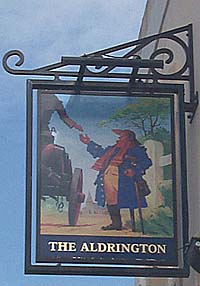Three hundred people - a three quarter person

Sign for The Aldrington pub
From a private collection
Apparently there were only 8 or 9 people living in Aldrington in 1603. This rose to around 200-300 by 1670.
Later, the storms of 1703 and 1705 created havoc, and the population dwindled in Victorian times, but what exactly happened to those people? Did they fall into the sea?! In 1831 the population was recorded as being just two (the gate keeper and his wife).
The best ‘early’ story I have found concerns the toll-gate keeper. Apparently, he lost his leg after which his wife left him. The official records then state the population being only 3/4 of one person!
This falls into place, when you see the sign for the The Aldrington pub.




Comments about this page
I am not sure about those 17th century population figures! The parish lost a deal of its land as a result of continued erosion of the soft coastline. Aldrington,certainly by the 19th century was basically a huge cornfield owned by the Fuller family and their relatives, the Ingrams. 19th century maps show the church as in ruins. As Brighton’s housing grew into Hove and the brickfields along the coastal plain were built over, the wide expanses of brickearth in Aldrington were exploited by the brickmakers. This was why nobody lived there other than a few itinerant brickmakers. During the 1880’s villas started to be constructed at the east and west ends of Church Road[renamed New Church Road when St Philips was built].The distinctive grid iron road pattern came about after the brickmakers wiped out all the hedges and usual landsdcape symbols giving a free field for later development. Much of the western end of Aldrington became part of Braybon’s West Hove Estate and was built around 1933-34 with some classic interwar suburban architecture and two lovely blocks of 1934 flats, Brittany and Mornington Mansions.The north eastern area of Aldrington was part of the Duke of Portland’s estate and was developed mainly as service zone working class,lower middle class housing for Hove’s light industrial and service industries.
North of the railway and running up to Hangleton [Elm Drive area]was the Aldrington Manor Estate, again a set of classic interwar suburban dwellings.
Add a comment about this page